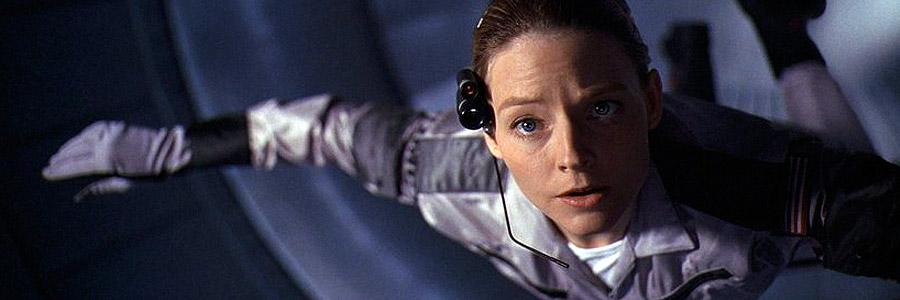
Contact
Warner Bros.
Original release: July 11th, 1997
Running time: 150 minutes
Director: Robert Zemeckis
Writers: James V. Hart, Michael Goldenberg, Carl Sagan, Ann Druyan
Composer: Alan Silvestri
Cast: Jodie Foster, Matthew McConaughey, James Woods, Tom Skerritt, William Fichtner, John Hurt, Angela Bassett, David Morse
Hadden and Ellie meet: 0:58-1:04
Deconstructing Cinema: One Scene At A Time, the complete series so far
“Do we, holding that gods exist, deceive
ourselves with insubstantial dreams
and lies, while random careless chance
and change alone control the world?”
~ Euripides (Hecuba)
Contact is a 150-minute rollercoaster ride through a multiverse of emotions, love, life, death, science, religion and philosophy — revolving around one of humanity’s oldest questions: Are we alone in the universe?
This seems like an awful lot of ground to cover even for an epic like Contact, and maybe it was too much for some audiences. With all in all average reviews, the movie was placed on par with classics like Close Encounters of the Third Kind (1977) and 2001: A Space Odyssey (1968) by some critics. ¹’²
To me, Contact is one of the most incisive film experiences. When the movie hit the big screen in 1997, I had no deep interest in extraterrestrial life or the 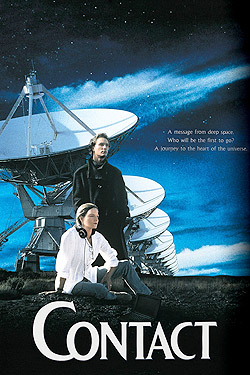 search for it. However, I’ve always found the questions this subject poses interesting, if not intriguing. Contact challenges perceptions that are trapped either in a materialistic world view or in quasi-religious aspirations, and it does so in extremely sensitive and magical ways.
search for it. However, I’ve always found the questions this subject poses interesting, if not intriguing. Contact challenges perceptions that are trapped either in a materialistic world view or in quasi-religious aspirations, and it does so in extremely sensitive and magical ways.
Carl Sagan, an American astrophysicist, cosmologist and science popularizer, conceived the idea for the film in 1979. After the production got stuck in development hell, Sagan published Contact as a novel in 1985. Tragically, the popular astronomer who thought scientists should seriously study the UFO phenomenon, lived so see the movie go into production but died before it was finally released.
He had high hopes for the film, knowing that science has its hot spots that, even if based on facts, will remain unpopular.
Until today, I’m deeply mesmerized by Contact‘s main character, Dr. Eleanor “Ellie” Arroway (Jodie Foster). She works at the Search for Extraterrestrial Intelligence (SETI) institute, listening to radio transmissions in the hope of finding signals sent by an extraterrestrial intelligence.
Dr. Arroway is an extremely gifted and passionate, if not obsessive, scientist who blames herself for the death of her father, who died when she was 10. Throughout the film, it seems her search for alien signals is also a search for the soul of her father, a longing that will be answered late in the story but also introduces the rather religious subtext of the movie.
After the government pulls the funding from Ellie’s program, she is secretly backed and financed by billionaire S.R. Hadden (John Hurt) who’s had an eye on Ellie’s career since she was a teenager. A few years later, Arroway actually discovers an extraterrestrial broadcast with embedded codes that appear to compile blue prints of some sort, all in all some 60,000 pages.
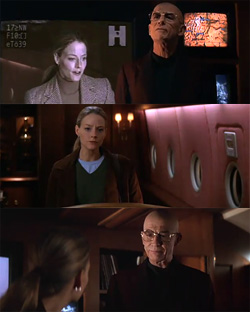 Obviously, the incident quickly becomes a matter of national security and egomaniac specialists who nonetheless can’t seem to solve the riddle of those pages. It seems the primer is missing that would make the fragments form a whole.
Obviously, the incident quickly becomes a matter of national security and egomaniac specialists who nonetheless can’t seem to solve the riddle of those pages. It seems the primer is missing that would make the fragments form a whole.
In the story, the pieces fall into place at this point — for Ellie, for her secret benefactor, and for the actual message of the film. It’s one of the key scenes in Contact, connecting the strings with a rather quiet interlude.
Ellie is “summoned” to see Hadden who has backed her for years from the sidelines. They meet on Hadden’s plane, since he likes to keep his interests mobile, as he puts it.
I’ve had my eye on you a long time, doctor…
I consider you one of my most valuable long term investments. And when it comes to my investments, I always do my homework.
Hadden tells Ellie the story of her life from his perspective, in a rather matter-of-fact way. His respect for Dr. Arroway’s achievements is palpable; it also alludes to the fact that Ellie is a female scientist in a male-dominated science world, something Dr. Jill Tarter who Ellie’s character is inspired by, found worth stressing as well. 4
The powers that be have been very busy lately, falling over each other to position themselves for the game of the millennium…
Maybe I can help deal you back in.
ELLIE
I didn’t realise that I was out.
HADDEN
Oh, maybe not out but certainly being handed your hat.
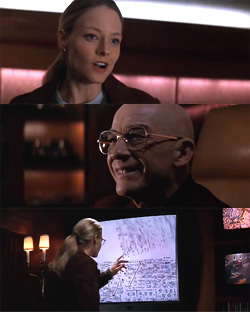 Then Hadden reveals the primer is hidden in the pages. He introduces his revelation with a statement that, in a way, sums up the dilemma of modern civilisation and reminded me of the famous Einstein quote that “we can’t solve problems by using the same kind of thinking we used when we created them.”
Then Hadden reveals the primer is hidden in the pages. He introduces his revelation with a statement that, in a way, sums up the dilemma of modern civilisation and reminded me of the famous Einstein quote that “we can’t solve problems by using the same kind of thinking we used when we created them.”
An alien intelligence is gonna be more advanced, and that means efficiency, functioning on multiple levels, and in multiple dimensions.
ELLIE
Yes, of course!…
Where is the primer?
HADDEN
You see, every three-dimensional page contains a piece of the primer… There it was, all the time, starring you in the face.
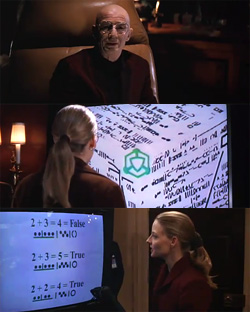 Eventually, Hadden and Ellie part with a sentence spoken by both of them, fading into the next scene:
Eventually, Hadden and Ellie part with a sentence spoken by both of them, fading into the next scene:
Buried in the message itself is the key to decoding it.
The alien message turns out to be a detailed instruction on how to build a complex machine, a teleporter of sorts that allows contact with the intelligence that originally sent the broadcast.
From this scene on, the events unfold in a more worldly and predictable way. In the end it will be Ellie who we see travelling through wormholes, and although the question whether or not we are alone in the universe seems answered, the story denies a definitive conclusion about the nature and intentions of that far-away civilisation.
15 years after its release, the message of Contact is as valid as ever, not only because the story was conceived by a revered astronomer who gave science a popular voice. To me, Contact is about connecting to ourselves, with open eyes and without prejudice.
1. Review by Roger Ebert
2. Review by James Berardinelli
3. Radio interview with Carl Sagan (1996)
4. Contact the Movie | SETI Institute
“Buried in the message itself is the key to decoding it.” If this is true in a wider sense, we might be the message, and the answer to the most essential question humanity can possibly ask lies within us rather than in the far reaches of the universe… Sometimes I wonder why there have been so few movies since Contact that approached the Alien subject beyond battles and scenarios of annihilation.
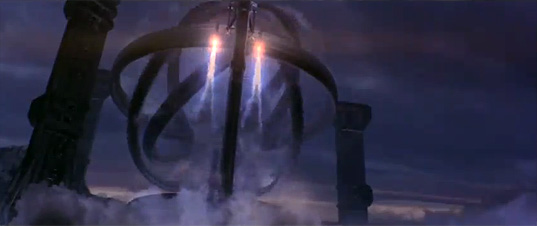

Jonahh Oestreich
One of the Editors in Chief and our webmaster, Jonahh has been working in the media industry for over 20 years, mainly in television, design and art. As a boy, he made his first short film with an 8mm camera and the help of his father. His obsession with (moving) images and stories hasn’t faded since.
You can follow Jonahh on Twitter @Jonahh_O.
© 2022 STATIC MASS EMPORIUM . All Rights Reserved. Powered by METATEMPUS | creative.timeless.personal. | DISCLAIMER, TERMS & CONDITIONS
HOME | ABOUT | CONTACT | TWITTER | GOOGLE+ | FACEBOOK | TUMBLR | YOUTUBE | RSS FEED
CINEMA REVIEWS | BLU-RAY & DVD | THE EMPORIUM | DOCUMENTARIES | WORLD CINEMA | CULT MOVIES | INDIAN CINEMA | EARLY CINEMA
MOVIE CLASSICS | DECONSTRUCTING CINEMA | SOUNDTRACKS | INTERVIEWS | THE DIRECTOR’S CHAIR | JAPANESE CINEMA





